Cite this document
(Descriptive Definition of Religion Essay Example | Topics and Well Written Essays - 1250 words, n.d.)
Descriptive Definition of Religion Essay Example | Topics and Well Written Essays - 1250 words. https://studentshare.org/philosophy/1724246-define-religion
Descriptive Definition of Religion Essay Example | Topics and Well Written Essays - 1250 words. https://studentshare.org/philosophy/1724246-define-religion
(Descriptive Definition of Religion Essay Example | Topics and Well Written Essays - 1250 Words)
Descriptive Definition of Religion Essay Example | Topics and Well Written Essays - 1250 Words. https://studentshare.org/philosophy/1724246-define-religion.
Descriptive Definition of Religion Essay Example | Topics and Well Written Essays - 1250 Words. https://studentshare.org/philosophy/1724246-define-religion.
“Descriptive Definition of Religion Essay Example | Topics and Well Written Essays - 1250 Words”. https://studentshare.org/philosophy/1724246-define-religion.


